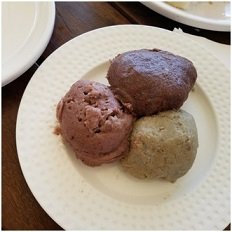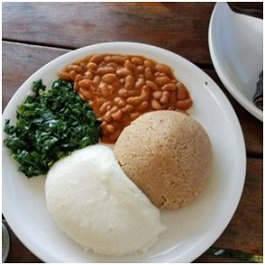Is Sadza Healthy? (Sadza AKA Ugali, Nshima, Posho, Fufu, Pap etc.)
In the interest of full disclosure, I will let you know that I am a person who loves sadza. In fact, I will confess to loving sadza so much that I freeze whatever is left in the pot and save it for the days when waiting 30 minutes for a pot to cook is simply out of the question.
Unfortunately, my beloved staple is constantly blamed for a slew of health problems. In boarding school, it was the girls who claimed sadza gave them “ulcers”. They avoided it but as provisions dwindled and hunger struck, ulcers were healed as they finished every morsel on their plate. Today, it’s the weight-watchers who blame sadza for weight regained after following a strict diet or the diabetics choosing to sustain themselves on meat and vegetables for fear of increased blood sugars.
Is sadza healthy?

Healthy carbs are minimally processed and include sorghum, rapoko and millet (pictured)
My grandfather used to tell me the pretty, soft, white stuff that we served with relish was not sadza but an imitation of the real thing. I never quite understood what he meant and often dismissed his thoughts to “old age.” but now I get it.
Carbohydrates (carbs) are the major nutrient in sadza and healthy carbs are those that are minimally processed and high in fibre, a nutrient that has been linked to weight loss, blood sugar control, cancer prevention and overall good health. They include many of Africas roots and tubers (cassava, yam, plantain, cocoyam, sweet potato etc.) and grains (millet, sorghum, rapoko, maize etc.). For my grandfather, “real” sadza was made from millet, sorghum and straight run maize meal, 4 of Zimbabwe’s healthiest stable grains.
However, associated those grains with a rural, primitive lifestyle and wanted the super refined, soft, white sadza. Grandfather was right; the fluffy white stuff that I preferred went down so smoothly because it was highly refined – a process that removes most of the vitamins and minerals of the whole maize grain.
Is sadza fattening?
So, if sadza is a carb…then it must be fattening, right? Well, not so fast. Carbohydrates have been the unfortunate villain of a weight loss industry that has labelled them as being the “bad” nutrient. But in case you have not received the memo, let me share the news with you, “Carbs are NOT fattening… excess calories are!” Weight control is about ensuring a balance between calories consumed (what you eat) and calories burnt (what you use). Too many calories equal weight gain, too few calories result in weight loss and just the right balance equals weight maintenance.
There are however, some diet and lifestyle choices that have contributed to why sadza may be linked to our ever-expanding waistlines:
We eat the same size portions as we did 20 years ago but move less
Our lives today have been enhanced with the luxuries of modern technology and entertainment. We sit in front of big and small screens for hours on end, drive to most places, avoid exercise and yet we eat the same amount of food (if not more) as we did when we were a lot more active – walking everywhere, working in fields from dawn till dusk, playing “Christopher Columbus” and “sweetie”, you get the picture.
The result of unused calories is an inevitable increase in waistlines and weight.We serve sadza with large portions of meat and little vegetables

The average plate contains very little vegetables.
The taste of sadza is only as good as the relish it is served with and so to make sure that every morsel that enters our mouth is loaded with flavour, we pack our plates with plenty of relish. With the increased availability of animal protein, meat has become our relish of choice and instead of using meat as flavouring for vegetables, we now use the vegetables to add flavour to the meat. Furthermore, the average African plate contains a mere garnish of low calorie, nutrient rich vegetables.
With animal products containing more fat (and calories) than vegetables coupled with our chronic lack of exercise, our calorie-exercise ratio is thrown off balance.
- We use maize meal that is highly refined and low in fibre
As previously mentioned, refined grains have the fiber removed. Fibre is essential because it curbs hunger by promoting satiety. In fact, when it comes to fighting the battle of the bulge, studies continuously demonstrate that people who consume enough fibre tend to have healthier body weights than those who do not. Tanzanian Food Composition Tables suggest that people who consume millet with sorghum-based (sadza) consume 22 percent less ugali than those that eat maize meal-based ugali. The difference in portion size can directly be credited to the fibre content of the millet with sorghum.
The higher the fibre, the greater and quicker the satiety and smaller the portion
The right proportions of starch, vegetables and protein will ensure a balanced diet.
Is sadza good for diabetics?

Sadza portion should not exceed 1 1/2 times a fist
There is a fallacy that diabetics should not have any carbs because carbs increase blood sugars. One of the most effective methods for controlling blood sugars is to ensure the adherence to a healthy, well-balanced diet. Carbohydrates are part of a healthy meal plan and the body’s preferred source of energy. It is okay for a diabetic to have sadza but what is important is the portion size, the type of maize meal used and meal balance.
Since blood sugars respond directly to the amount of food eaten, portion control is essential. The bigger the portion, the greater the spike in blood sugars. A simple method of estimating portion size is the “Plate Method” which recommends that 1/2 your plate be fruits and/or non-starchy vegetables (tsunga, cabbage covo and the like), 1/4 be protein foods (beans, chicken, fish etc) and the other 1/4 sadza.
The Bottom Line
• Go for the whole grain. The further away from white, the higher the fibre, the healthier the grain and the better the nutrition. This is especially important for weight watchers or people with diabetes as the fibre in the grain helps control blood sugars and keep one full longer
• Watch your portions. If your portion size is larger than 1 ½ fists…you may be eating too much.
• Rule of thumb to remember: Make half your plate vegetables and/or fruit; a quarter meat; and the other quarter sadza.
•Enjoy sadza! A culture of a people is partly defined by their diet and what they eat. Sadza is part of our heritage and we should continue to include it in our diets. For what it’s worth, our fore fathers thrived on sadza and were healthy as can be.
Nutrient information for weight watchers
100 g Maize sadza (no specific mealie meal type indicated in research) provides Kcal (KJ) – 123.8 (515.2), 2.7 g protein, 1.2 g fat, 25.6 g total carbohydrates, 2.4 g fibre.
(Average serving size is 450 g which equals 557 calories and 115g carbohydrate)
100 g Maize + sorghum sadza* provides Kcal (KJ) – 110 (460), 3g protein, 0.9 g fat, 24.7 total carbohydrate, 4.3 g fibre.
(Average serving size is ~350 g which equals 385 calories and 86.45 g carbohydrate.)
100g Sorghum + millet sadza* Kcal (KJ) – 112 (468), 3.4 g Protein, 0.9 g Fat, 24.7 g total carbs, 4.3 g fibre.
Hi! I am a robot. I just upvoted you! I found similar content that readers might be interested in:
https://theafricanpotnutrition.com/2017/12/27/is-sadza-healthy/
yummy😋 that looks delicious😍